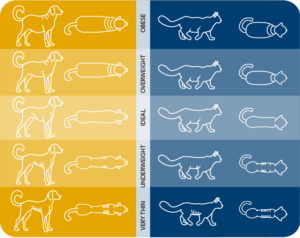
Nutrition for your pet should be evaluated just like yours is. Check the nutrition label on your pet’s food to see what’s in it. Look for foods that are meat-based with high-nutrient value ingredients. Generally, the first three lines should include protein, fruits and vegetables, and grains.
Our recommendations for feeding your pet are based on the science of nutrition. With this foundation, we can help you better understand your pet food choices. Choosing healthier foods results in your pet’s improved health and quality of life. After all, “healthier” doesn’t have to mean more expensive.
How much should you feed your pet?
Portion size may vary based on breed, age, and health condition, and settling on the right amount can be tricky.
The correct meal size depends on factors like:
- Type of food
- Number of meals
- Body weight
- Metabolic rate
- Amount of exercise
Most pet food labels have suggestions based on your pet’s weight. These suggestions are pretty general and may be too high to maintain a healthy weight because they don’t take into account your pet’s lifestyle or breed. Some pets may require more or less food than the guidelines, depending on activity level and other factors. For example, a 35-pound Corgi that tends to gain weight might need to start with less food than the label recommends. Combine this information with your veterinarian’s recommendations to come up with the initial amount of food to offer your pet for a long and healthy life.
When should you feed your pet?
The general rule of thumb is to feed your pet twice a day. For instance, feed your pet in the morning while you eat breakfast and in the evening when you sit down to eat dinner. This is not a hard-and-fast rule and may be different for your pet and lifestyle.
Healthy Body Weight
Your veterinarian can assess your pet’s weight and overall health, then make recommendations regarding weight, diet, and exercise. They can also teach you to assess your pet’s body condition by observing body shape and feeling certain parts of your pet’s body. A healthy weight isn’t simply a number on a scale; it’s about healthy body composition.
The benefits of keeping your pet at a healthy weight
Excess weight can reduce your pet’s life expectancy by more than two years! Keeping your pet trim gives them the best chance of a longer, healthier, and pain-free life. When your pet is at a healthy weight it will lower their risk of diabetes, high blood pressure, respiratory disease, kidney disease, and some forms of cancer. It can also reduce the risks of injury to bones, joints, and muscles that are associated with excess weight. If your pet has arthritis, keeping them at a healthy weight makes it easier to manage the discomfort associated with joint pain.
